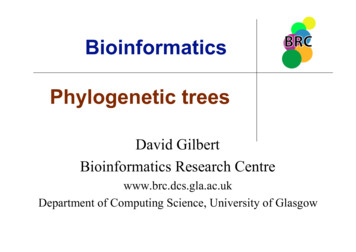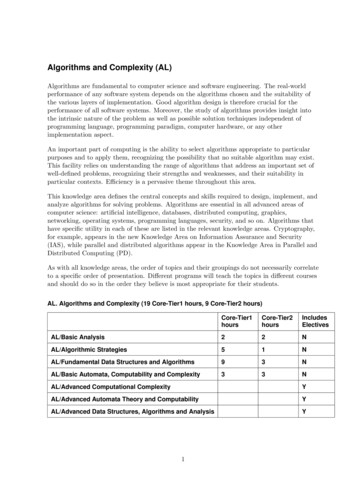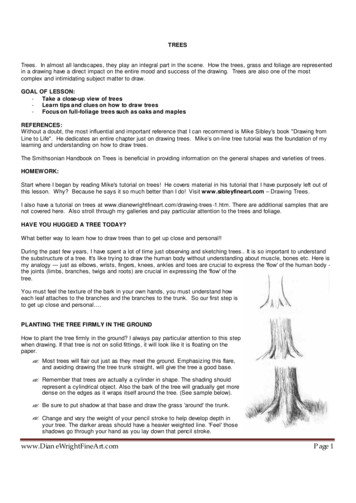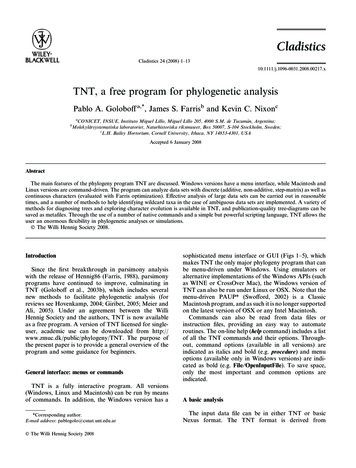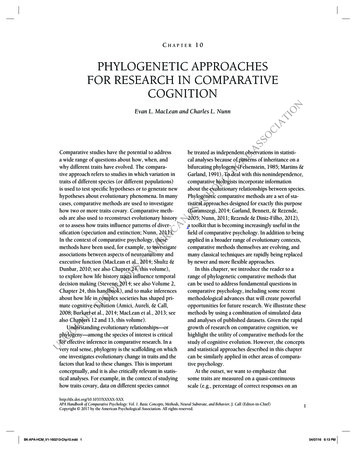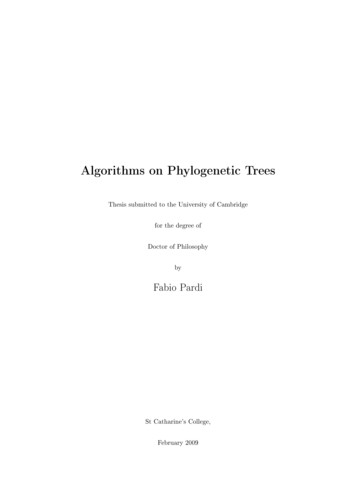
Transcription
Algorithms on Phylogenetic TreesThesis submitted to the University of Cambridgefor the degree ofDoctor of PhilosophybyFabio PardiSt Catharine's College,February 2009
Except where otherwise stated in the text, this dissertation is the result of my ownwork and is not the outcome of work done in collaboration.This dissertation is not substantially the same as any I have submitted for a degree,diploma or other quali cation at any other university; and no part has already been,or is currently being submitted for any degree, diploma or other quali cation.This dissertation does not exceed the permitted length.Fabio Pardi
ContentsSummary5Acknowledgements6Chapter 1.7Introduction1.1.Phylogenetics71.2.Problems and algorithms91.3.Outline of the thesis111.4.Approximation algorithms for MP and AML121.5.Analysis of proposed ENCODE transcripts14Chapter 2.Measuring and optimising diversity in a tree: phylogenetic diversityand a greedy algorithm162.1.Picking leaves from a tree162.2.PD in conservation biology172.3.PD in comparative genomics212.4.Other applications?252.5.Formal de nitions: rooted and unrooted PD272.6.A simple PD-optimisation problem292.7.A greedy algorithm302.8.Examples312.9.The algorithm's correctness322.10.The moral of the story: being greedy works372.11.Beyond PD: Genetic Diversity and Feature Diversity392.12.Related work41Chapter 3.Including costs: the budgetedMaxPDproblem and dynamicprogramming solutions433.1. All animals are equal, but some animals are more equal than others 3.2.The budgeted3.3.Computational complexity3.4.An453.5.A523.6.The unrooted case583.7.Examples623.8.Related work65MaxPDproblem434445O(B 2 n)-time dynamic programming algorithmO(Bn log n)-time dynamic programming algorithm3
CONTENTSChapter 4.4Including survival probabilities: future PD and the Noah's Arkproblem674.1.The missing ingredient in conservation biology: extinction risks674.2.A simple extinction model and asymptotic distribution of PD684.3.An algorithm to derive the distribution of PD714.4.A simple problem where conservation ensures survival and its solution764.5.Examples784.6.The Noah's Ark problem794.7.Extinction interdependencies and the nature reserve problem844.8.Related and future work86Chapter 5.The generalised Noah's Ark problem and its solution895.1.The beauty of curves: general e ects of conservation on survival895.2.The generalised Noah's Ark problem905.3.An algorithm for the5.4.Examples1045.5.The algorithm's e ciency and experiments1075.6.Related and future work110Chapter 6.gNAP91Balanced minimum evolution as a criterion for tree reconstruction 1126.1.BME: fast and accurate distance-based tree reconstruction1126.2.Distance methods and minimum evolution1136.3.Balanced tree length estimation: Pauplin's formula1146.4.Some mathematical facts on BME1236.5.Relation between BME and the neighbor-joining algorithm1276.6.Safety radius for the BME criterion1306.7.Heuristics for BME1366.8.Related and future work139Chapter 7.A branch and bound approach for BME-optimal trees1427.1.An exact algorithm for BME: is the best the enemy of the good ?1427.2.A branch and bound algorithm for BME1437.3.Bounds for BME1517.4.Computational aspects1737.5.Experiments1767.6.Discussion and Future Work182ConclusionAppendix:184species abbreviations in gures 2.8.1, 3.7.1, 4.4.1 and 5.4.1186Bibliography187Index198
SummaryAlgorithms on Phylogenetic Trees by Fabio PardiThe simultaneous rise of digital computers and molecular biology fty yearsago spurred the development of several algorithms for biologically relevant problemsand the birth of computational biology (e.g, [MS57,ED66, NW70]). Arguablythe earliest among these were algorithms for inferring phylogenetic trees based onthe present characteristics of species or molecules [MS57,Sne57, SS63, ECS63,ECS64, CS65, ED66, CSE67, FM67]. Despite this long tradition, new optimisation problems on phylogenetic trees have continued to appear, and algorithmsdealing with them are an active area of research.This dissertation presents my work on the algorithmics of phylogenetic trees intwo separate directions: rst, I de ne and solve a hierarchy of optimisation problemsaiming to select a maximally diverse subset of taxa in a tree; second, I explorea recently-proposed distance-based criterion for reconstructing phylogenetic trees:balanced minimum evolution (BME).The rst direction of research is presented in Chapters 2 to 5. After introducinga measure of diversity for subsets of taxa in a tree and discussing its relevance toapplications such as conservation biology, I show that a simple greedy algorithm isguaranteed to select maximally diverse subsets of a xed size (Ch. 2). When insteadeach taxon has a cost and the selection is limited by a given budget (leading tothe possibility of selecting subsets of variable size), dynamic programming algorithmsbecome necessary (Ch. 3). A further improvement, in the context of conservationbiology, is to take into account di erent extinction risks for di erent taxa (Ch. 4).Selecting taxa for conservation so as to minimise the future loss of diversity leadsto a framework proposed by economists, called the Noah's Ark problem, which Igeneralise and tackle in Chapter 5.The rest of the thesis deals with BME. First, I illustrate the theoretical andempirical bases supporting the use of this criterion, including a novel result regardingits robustness to noisy estimates of pairwise distances (Ch. 6). Second, I present abranch and bound algorithm for BME; this is the rst practical algorithm guaranteedto construct optimal trees with respect to this criterion and I use it to investigatethe margins of improvement possible for current algorithms for BME (Ch. 7).A more detailed summary is given in Chapter 1 (Sec. 1.3), which also introducesthe main themes and terminology of this dissertation.5
AcknowledgementsAs I am writing this, it is very late at night. I am tired, but happy. Happy becauseI have nally written the last word of Chapter 5 (I seem to work non-linearly evenin the choice of what to do next). Happy because I have nally reached the tortoisethat was constantly moving away from me (I was starting to believe that I was, notAchilles, but the tortoise!). Happy because I can now turn to new things. I feel likethanking the whole world.However, that would be quite inaccurate there are some people who to whomI feel particularly grateful to. First and foremost my supervisor, Nick Goldman. Notonly has he taught me that sentences should never nish with a preposition, but alsothat if you really have to use priors, optimist priors are better. He always had wordsof encouragement when I needed them, and of advice when it was not clear what todo next. Thanks to him, I had the fantastic opportunity of spending three monthsdoing research in New Zealand, meeting other great people to work with and seeingwonderful places.I would also like to thank all the people who were and have been in my researchgroup during my time at the EBI. I have learned a great deal from them. In particularAri, Martin, Simon and Tim, whose time here has signi cantly overlapped withmine.Thank you also to Nick Luscombe, Toby Gibson and David MacKay, mythesis advisory committee from the EBI and beyond, whose suggestions were alwaysvery helpful.I am also very indebted to the beautiful people with whom I had the fortune ofcollaborating: Benny Chor, Mike Steel, Klaas Hartmann, Beáta Faller, Mike Hendy,David Penny, Barbara Holland, Ste en Kläre, Bui Quang Minh. Mike Steel in particular, was co-responsible for my exciting time in New Zealand.Writing a thesis is a stressful way of using one's energies and it tends to transformthe often-unaware student in a pretty peculiar creature. A special thank you goes tomy friends, who managed to be nice with that creature: to Rosie, Phil and Dominic(for still inviting me to dinner), to Beatriz, Luca and Mohammed (for being suchgood listeners), and to my housemates Chris and Rich (for washing my dishes sometimes and lifting my morale all the time). And of course to my beautifulAlyson, who met me late in the process of becoming that creature and still decidedthat she likes me (I think). She taught me that Zeno's paradox is wrong.Most importantly, I would like to thank my wonderful parents Daniela and Carlofor making me what I am (yes it is a thank you).6
CHAPTER 1Introduction1.1. PhylogeneticsPhylogenetics is the discipline concerned with the study of evolutionary relationships, in particular the reconstruction of phylogenetic trees from molecular ormorphological data (for example DNA sequences or fossils), their analysis, and theirapplication to yet other disciplines.A recent application of phylogenetics has been in the choice of species, for avariety of purposes where it is important to choose species that span large portionsof the underlying phylogenetic tree. For example, in biodiversity conservation it isimportant to concentrate conservation e orts on sets of species that are as diverseas possible, so as to avoid the loss of extensive parts of the underlying evolutionaryhistory. Another example is genomics, where again it is desirable to sequence evolutionarily diverse sets of genomes as this allows many inferences to be drawn bycomparing them. For both bioconservation and genomics, diversity can be mathematically de ned in precisely the same way, as I will show in the next chapter. Alarge focus of my research (Ch. 2 5) has been to work on a number of optimizationproblems whose aim is to select from a tree a maximally diverse subset of its species.I am also interested in the most classical question in phylogenetics: how can weinfer the phylogenetic tree of a group of taxa, given their (present) characteristics?For a long time, morphological features were used for this task and it was left tothe good sense of the naturalist to reconstruct phylogenies, but with the advent ofmolecular sequence data (and computers to analyse them) it became clear that automatic procedures for phylogenetic inference were needed. Many di erent methodshave been developed in the past 40 50 years, starting from the pioneering work ofR.R. Sokal [MS57], P.H.A. Sneath [Sne57], L.L. Cavalli-Sforza, A.W.F. Edwards[ECS63,ECS64] and others. With very few exceptions, tree reconstruction meth-ods can be seen as optimisation algorithms looking for the tree that best ts theobserved data. They essentially di er in the criterion used to measure the degree oft between tree and data; for example parsimony, least-squares, likelihood. In thisthesis, from Chapter 6 onwards, I will present my work on a relatively new criterionfor tree reconstruction.Phylogenetics involves a large amount of specialised terminology, which I brie yintroduce in the rest of this section and use throughout this dissertation.7
1.1. PHYLOGENETICS8Phylogenetic trees are used to describe the historical relationships among anyobjects related via a process of common descent with modi cations. In the contextof biology, these objects can be genes, individuals, populations, species, genera, etc.;in other words any taxonomic unit of interest.As I am here concerned with thegeneral properties of phylogenetic trees, I will usually leave unspeci ed what thesetaxonomic units are and will refer to them as taxa.In a phylogenetic tree, taxaare represented by its leaves (see below for a de nition), and the rest of the treerepresents the ancestors of these taxa and the relationships between them.Depending on the amount of formalism needed for their investigations, someauthors (e.g., [SS03]) introduce their works with a formal de nition of phylogenetic trees, while others (e.g., [Fel03]) do not.Here, I adopt a very simple semi-formal approach. Throughout this thesis, a phylogenetic tree is a tree in the graphtheoretic sense (a collection of branches connecting unordered pairs of nodes, see,e.g. [CLRS01], Appendix B.5), subject to a few notes: a particular node may be designated as the root of the tree, in which casethe tree is said to be rooted ; otherwise it is unrooted ; all the non-root nodes that are attached to exactly one branch are calledleaves and their corresponding branches are called terminal branches ; thenodes that are not leaves are called internal nodes and the branches thatare not terminal are called internal branches ; there is a one-to-one correspondence between leaves and taxa of interest; as aconsequence, I will often use the words leaves and taxa interchangeably;ifXis the set of taxa in a phylogenetic tree, we say that that tree is overX; branches have often associated with them real numbers representing theamount of evolution that has occurred between their two extremes (thiscould be time if taxa are species, or the expected number of substitutionsper site if taxa are molecular sequences); these numbers are called branchlengths ; in this thesis, trees with branch lengths are denoted with calligraphic fonts such as T;a rooted tree with branch lengths,T,is said to be ultrametric if the sumof the lengths of the branches on the paths from the root to any leaf isconstant; note that in this case it is justi ed to interpret branch lengths astimes; when a tree does not have lengths associated with its branches, that tree iscalled a tree topology ; in this thesis, tree topologies are denoted with normalitalic fonts such asT ifTT;a tree with branch lengthsis what is obtained by strippingTTis said to have topologyof its branch lengths;two trees are e ectively considered to be the same, and we writeT1 T2 ,T1 T2orif they represent the same information; this can be formalised by
1.2. PROBLEMS AND ALGORITHMS9introducing a notion of isomorphism between trees, but for simplicity I willavoid doing so; a tree is said to be bifurcating if all non-root internal nodes are attached toexactly three branches and the root is attached to either one or two branches;nodes attached to more than three branches are also called multifurcations ;a multifurcating tree is one containing multifurcations;Lastly, there is one more requirement that I only add for consistency with most literature in phylogenetics (but very few results in this thesis depend on this assumption): no non-root node is attached to exactly two branches.Note that because of this last requirement, all trees are either bifurcating or multifurcating.1.2. Problems and algorithmsMany algorithms, certainly all the ones that I deal with in this thesis, are devisedin response to a well-de ned problem. A problem is well-de ned when it speci es thepossible inputs it can have (its instances ) and their corresponding desired outputs.Examples of classic problems are: given the distances between a number of cities, nd a shortest possible tourthat visits all the cities (the traveling salesman problem ); given an integer number, determine whether it is prime or not;given a program written in a known computer language, determine whetheror not this program will ever terminate execution (on an infallible computerwith in nite memory and given in nite time).Among the examples above we can distinguish between optimisation problems (suchas the rst one), where the aim is to nd an optimal solution in a set of candidatesolutions, and decision problems (such as the second and the third), where we seeka binary answer yes/no. There are other types of problems besides optimisation anddecision problems. In this dissertation I will only deal with optimisation problems.Problems are not only categorised on the basis of the types of answer they seek,but also on the basis of how complex it is to compute the answers. For some problems, there is no algorithm giving always the correct answer [Tur36]. For most ofthe problems encountered in practice, however, the complexity of their solution ismeasured in terms of the amount of computational resources (typically time andmemory space) that algorithms need in order to compute the correct output. I nowintroduce the essential notions needed to discuss the computational complexity ofthe algorithms and problems encountered in this thesis. For more information, theinterested reader may consult one of many excellent textbooks (e.g., [CLRS01], PartI and Ch. 34).In this dissertation I will often use theO( )notation to indicate the amount ofresources (time, memory) used by an algorithm. This notation is standard both in
1.2. PROBLEMS AND ALGORITHMScomputer science and biology (e.g., [SK88,RN93, BW98]). Let10nbe a quantitydescribing (some aspect of ) the size of the input for example, in the case of analgorithm working on a phylogenetic tree, the number of taxa in the tree.Then,O(f (n)) time (or uses O(f (n)) memory) where f (n) isa function of n (e.g., f (n) n log n) if there exists a constant c such that thealgorithm's running time (or memory usage) is at most cf (n) for every possible inputcorresponding to n. Note that this de nition is independent of the the units used toan algorithm runs inmeasure time or memory space. It is also important to note that, unless otherwisespeci ed, the notationO(f (n)) indicates a guarantee on the worst-caseperformanceof an algorithm: for example, there are well-known sorting algorithms that run inO(n log n) time in the majority of cases, but for which some inputs may require time2proportional to n ; in this case the best we can say without making any distinction2between inputs is that the sorting algorithm runs in O(n ) time.Another useful notion for this thesis is that of NP-hardness. Many computationalproblems of practical relevance (and in this thesis we shall encounter a few) can beproved to be NP-hard. The importance of identifying a problem as NP-hard is thatthis is strong evidence that there is no polynomial-time algorithm solving it apolynomial-time algorithm is one running inwherenO(p(n))time for some polynomialp,measures the amount of memory that is necessary to store the input.In order to provide a de nition of NP-hard problems, we need a number of otherde nitions: P is the class of decision problems that can be solved by a polynomialtime algorithm.NP is the class of decision problems for which there exists apolynomial-time randomised algorithm using a polynomial number of random bitssuch that: if the correct answer to the problem is no, then it always returns no ; if thecorrect answer to the problem is yes, then it returns yes with nonzero probability.For example, it is not di cult to see that the decision version of the traveling salesman problem above, where one asks whether there is a tour shorter than a speci edthreshold, is in NP. A particularly important discovery was that there is a subset ofNP, whose elements are called NP-complete problems, for which the existence of apolynomial-time solution implies that every problem in NP has a polynomial-timealgorithm solving it [Coo71,Kar72], in other words that the classes P and NP co-incide. After almost 40 years, no polynomial algorithm for any of these problem hasbeen found, but neither has a proof thatP 6 NP been provided (and this constitutesthe most important open problem in theoretical computer science).What confers NP-complete problems their special status is that it is possibleto prove that every problem in NP can be reduced in polynomial time to any NPcomplete problem, where reducing means transforming the input of a problem intothe input of another so that the desired output for the latter problem can be used tocompute (again, polynomially) the output for the former. This implies that if therewere a polynomial-time algorithm for a NP-complete problem, then this algorithm
1.3. OUTLINE OF THE THESIS11could be used to solve, after an appropriate reduction, any problem in NP in polynomial time. NP-hard problems are the same as NP-complete problems, but withoutthe requirement of being members of NP: they are all problems (including also optimisation problems) to which every problem in NP can be reduced in polynomialtime. Clearly, in order to show that a problem is NP-hard, it su ces to show thatanother known NP-hard problem reduces to it in polynomial time.Knowing that a problem is NP-hard strongly suggests that there is no polynomialalgorithm solving that problem.In these cases, it becomes reasonable to deviseheuristics algorithms that have no guarantees on the quality of the producedsolution.1.3. Outline of the thesisAlthough the rst section of each chapter gives an overview of its contents, I nowoutline the contents of each chapter in a more concise way.Chapter 2 introduces the phylogenetic diversity (PD) of a set of taxa, a quantitative measure of their diversity that takes into account their evolutionary relationships.PD is relevant for choosing taxa in a variety of applications, ranging fromconservation biology, where the aim is to save from extinction the maximum amountof biodiversity, to comparative genomics, where sequencing a diverse set of genomesensures good statistical power for tests aimed at nding interesting genomic features(e.g., conserved elements).Somewhat surprisingly, the problem of selecting thetaxa with maximum PD from a phylogenetic tree which I callMaxPDk canbe solved with a simple greedy algorithm, a nice property formally proved in thesecond part of Chapter 2.Chapters 3, 4 and 5 deal with a hierarchy of optimisation problems that generaliseMaxPDby introducing more realistic and complex constraints on the selection andby extending its objective function. Each problem in this hierarchy is a particularcase of the ones that follow.Chapter 3 de nes and solvesBMaxPD,the budgeted version ofMaxPD,wheredi erent taxa require di erent amounts of resources (money, time, labour, etc.) fortheir selection (sequencing or conservation) and a limit is set on the total amountof resources available (a budget). This problem is computationally harder than theprevious one, but I provide a number of dynamic programming algorithms which rune ciently when the budget is not too large.Chapter 4 introduces the next problem in the hierarchy, which has previouslybeen referred to as the Noah's Ark problem (NAP). The NAP more realisticallymodels the choices that have to be made in conservation biology, as it takes intoaccount taxon-speci c extinction probabilities clearly an important factor whenselecting taxa for conservation. The objective now is to choose a subset of taxa toconserve so as to maximise the expected future PD , that is the PD of the speciesthat will survive until some speci ed future time. It turns out that in its simplest
1.4. APPROXIMATION ALGORITHMS FOR MP AND AMLform, where conservation can ensure survival, the NAP can be reduced to12BMaxPD.In the rst half of Chapter 4, I also investigate the distribution of the future PDresulting from all possible extinction scenarios.Chapter 5 deals with thegNAP,a realistic generalisation of the NAP, where foreach taxon, instead of making a binary decision between conservation and neglect,we can choose an amount of resources to allocate for its conservation, given thatthe probability of survival of that taxon is a known function of that amount.Inother words, we aim to nd the best way to distribute the available resources amongthe taxa under consideration, again with the objective of maximising the expectedfuture PD. For this problem, we can extend one of the approaches described inchapter 3, but I have been unable to prove whether worst-case polynomial behaviourholds. Therefore, I show that on many typical instances of this problem the proposedalgorithm is reasonably e cient.In Chapter 6, the focus switches to the classical problem of phylogenetic treereconstruction.In this chapter, I introduce and review a criterion for tree recon-struction based on pairwise distances between taxa: balanced minimum evolution(BME). This allows us to derive (partly novel) results that lay the ground for thefollowing chapter. The main novel result here is about a safety radius for BME:if the input distances are within a neighbourhood with this radius of the correctdistances, then the BME criterion is guaranteed to identify the correct tree.Finally, Chapter 7 presents my original work on BME. In order to investigatethe gains that can be obtained by improving the existing heuristics, I designed andimplemented an exact algorithm for this criterion; that is, one that is guaranteed togive optimal solutions. It uses the branch and bound strategy, a typical approachto tackle problems for which a polynomial solution is not available.My experi-ments with the implemented program are only preliminary, as some components ofthe algorithm leave scope for improvement. These experiments nevertheless suggestdirections for future investigations, which I discuss in detail.Other research that I have carried out during the course of my PhD is not presented in this dissertation. A brief description and pointers to the publications thiswork has led to are provided in the next two sections.1.4. Approximation algorithms for MP and AMLAs I mentioned before, tree reconstruction methods essentially di er in the criteria used to measure the t between tree and data. Interestingly, nding optimal treeswith respect to some of the proposed criteria, namely maximum parsimony (MP) and 04], can be seen as special cases ofancestral maximum likelihood (AML) [ABCHthe Steiner tree problem, where given a set of points in a metric space one has tond a tree of minimum total length connecting all these points [FG82,HRW92].The Steiner tree problem is well-known and a number of algorithms have beenproposed for this problem. In the case where the space under consideration has nite
1.4. APPROXIMATION ALGORITHMS FOR MP AND AML13size (i.e., a weighted complete graph), approximation algorithms giving solutionswith a score within a guaranteed factor of the optimal solution have been devised(e.g., [RZ06]).What MP and AML have in common is that, given a set of sequences of equallengthmin input, they aim to jointly reconstruct a phylogenetic tree and the se-quences at the internal nodes of the tree, so as to minimise d(x, y),x,ywhere the sum is over all pairs of sequencesbranch in the tree andd(x, y)AML essentially di er for howx, yappearing at the extremes of ais a measure of the distance between them (MP andd( )is de ned). This formulation makes it clear thatMP and AML are special cases of the Steiner tree problem, where the underlyingmetric space is the set of all the possible sequences of lengthbym with distances de nedd( ).In 2006, I joined the then-ongoing work by Benny Chor and colleagues, who wereinvestigating the possibility of adapting the existing approximation algorithms forthe Steiner-tree problem to MP and AML tree reconstruction. This is not straightforward: these algorithms run in polynomial-time in the size of the space, which inthis case is exponential inm.A closer look at these algorithms, however, revealsthat all that is needed is a subroutine that can construct optimal trees for a smallnumber ofksequences (e.g., 3 or 4) (polynomially in m, but not necessarily in k ).Then an approximately-optimal tree for all the sequences in input can be obtainedfrom these small optimal trees.Constructing such a subroutine for MP is easy: it simply consists of a brute-forceexamination of all possible tree topologies (where calculating the parsimony scorefor each topology can be done with the Fitch algorithm [Fit71]). For AML, this ismore complicated, as no equivalent of the Fitch algorithm is known for AML. This iswhere I gave my contribution to this work: I helped Benny Chor and collaboratorsto characterise solutions to AML forconvoluted casek 4:k 3sequences and especially for the moreit turns out that optimal ancestral sequences can be foundin a small set of candidate sequences.The results of this work are approximation algorithms for MP and AML thatconstruct trees whose score is within a guaranteed factor from the optimal score:16/9for AML and approaching 1.55 for MP. These results were published in IEEE/ACMTransactions on Computational Biology and Bioinformatics [ACPR09]. Since theseapproximation ratios are only worst-case guarantees, it remains to be seen how goodthe algorithms are in practice, and whether it is useful to combine them with thetraditional heuristics for these problems.
1.5. ANALYSIS OF PROPOSED ENCODE TRANSCRIPTS141.5. Analysis of proposed ENCODE transcriptsPhylogenetic methods are extensively used in analyses comparing genomes acrossdi erent species, helping to identify genomic regions with functionally importantroles. Throughout the rst period of my doctorate study, I was involved in the ENCODE (ENCyclopedia Of DNA Elements) project, a large collaborative e ort aiming 04, BSD 07]. Theto identify all functional elements in the human genome [FGGproject was then in its pilot phase , consisting of the evaluation and development ofseveral high-throughput techniques both computational and experimental ona set of 44 genomic target regions representing about 1% of the human genome.The aim was to determine the best strategy for analysing the remaining 99%, whichis the objective of the current ENCODE production phase .One important component of the project was the sequencing and comparativeanalysis of several other vertebrate genomic regions that are orthologous to the 44human targets [TTB 03, MBP 03, MVM 05, MCA 07]. Our research groupcarried out analyses of non-neutral evolution over all proposed protein-coding transcripts in these regions. I worked rst on the visualisation of the results and then,when it became clear that a signi cant proportion of the results were unrealistic, ontrying to understand whether the results could be used to assess the quality of thedata on which the analyses were based.A DNA site is said to evolve neutrally if selection has no role in its evolution.Non-neutral evolution occurs either when selection eliminates new mutations in thepopulation in
Summary Algorithms on Phylogenetic reesT by abioF ardiP The simultaneous rise of digital computers and molecular biology fty years ago spurred the development of .
